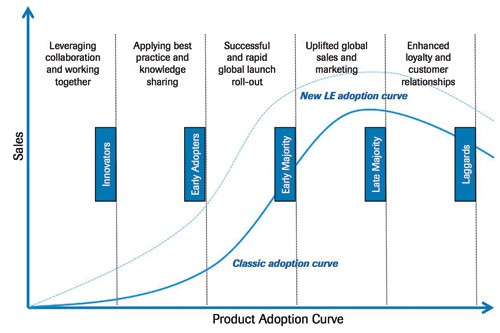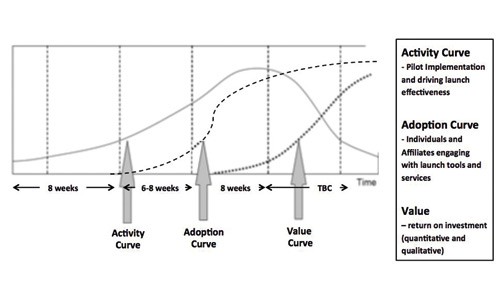
To introduce our subject, let us start with a quote from “the founder of modern management” – Peter Drucker, who stated that efficiency is doing things right; effectiveness is doing the right things. In many of his books and papers, these themes would be elaborated further exploring the confusion in companies between effectiveness and efficiency, explaining that there is surely nothing quite so useless as doing with great efficiency what should not be done at all.
Today, many of our internal processes, tools and resources focus on efficiency. What he argued was a way to identify the areas of effectiveness (delivering significant results) and a methodology for concentrating on them. In this article we will apply his approach to new product launch capabilities within the pharmaceutical industry.
The backdrop to this opportunity is the increasing financial pressure on companies to maximise revenue streams, as clinical development and trial programmes can cost many millions per molecule, coupled with existing small and large molecule drugs being quickly copied when their patents expire.
The increasing cost of bringing new treatments to market has led companies to invest heavily to upgrade their internal launch capabilities to optimise the time in reaching peak sales and maintain peak sales for longer. Examples abound on the cost of bringing a new molecule to market usually within the range of $1-2bn. This new ideal is reflected in our revised new product adoption curve, where successive studies have shown that overall product market performance is determined by the sales trajectory within the first six months of launch. To this end, it is imperative that new product launches are executed flawlessly and complement the overall corporate objective for consistent, successful multiple-product launches.

More positively, the increasing recent and ongoing investment in launch capabilities is also being aligned to the pharmaceutical industry riding a wave of new product launches leveraging recent investment in genomic research and advances in molecular technology. For example, one exciting area of research and discovery is using the body’s own immune system to fight cancer cells. Thousands of patients worldwide are in clinical trials with anti-PD-1 or anti-PD-L1 drugs produced by several pharmaceutical companies prior to the expected arrival of this new exciting class of treatment.
Companies have been expending considerable energy and resource to provide a ‘best-in-class’ capability for launching multiple products across local affiliates/markets quickly, consistently and successfully, with global and or regional launch teams as key investments in both resource and leadership. These teams seek to amplify and extend those launch capabilities with a view to drive launch success and achieve efficiencies across the organisation via cross-functional launch teams and communities.
Efficiency is doing things right; effectiveness is doing the right things
Complementing the increasing launch capabilities investment is the opportunity to follow the maxim from Peter Drucker and better understand those launch activities that deliver impact and value, using internal and external benchmarking and key performance indicators.
It could be argued that today’s and tomorrow’s question has evolved from delivering launch capabilities to driving launch effectiveness, following other previous trends like sales force effectiveness (SFE), commercial excellence and possibly six sigma used in manufacturing for process improvement, etc, where we are challenged not only to have launch capabilities but to demonstrate their effectiveness against internal/external metrics.
In our experience, launch team effectiveness (LTE) spans all four quadrants of our launch capabilities model leveraging key high level attributes like knowledge-sharing, behavioural change and organisational interdependencies as key components in encouraging employees to adopt a sharing, collaborative mentality. Developing an effective launch excellence programme requires an understanding of what works well, what is needed and the necessary working processes supported by the relevant tools and technologies.
Taking an external horizon scan of launch capabilities across the industry, we see many organisations initially driven by the need to launch new phase III molecules and indications investing on core capabilities. These are typically found on the left-hand side of our bespoke IE launch capabilities model focusing on launch strategies, planning and playbooks/frameworks.
As global/regional launch excellence teams expand both in scope and exposure, additional effort is placed on encouraging new brands and teams to come on-board and on some of our right-hand side activities like KPIs and communications.
Leadership is defined by results not by attributes
The outliers are those organisations that take a holistic approach to their launch capabilities, articulating a journey that takes features from across all four quadrants usually by leveraging across the key pillars of people, processes and platform.
In our experience, people are the most important variable in determining success and overall launch effectiveness. This usually begins with key internal stakeholders supported by senior leadership creating their launch excellence vision and roadmap, with the emphasis on co-creation and collaboration.
Launch effectiveness will be anchored on these change agents and communities and is further amplified as these internal stakeholders understand and apply KPIs.
The processes needed to support existing and new launch capabilities build on a common launch playbook or framework, which articulates the key activities that local, regional and affiliate teams need to follow to launch a new product. Ideally the launch playbook would be complemented with tools and technology – allowing launch teams to easily plan, manage and monitor their launch progress and performance.

Understanding launch effectiveness needs ongoing measurement and monitoring to ensure both return of investment in launch capabilities and also to gauge overall impact. The IE approach includes baseline and regular internal assessment of launch capabilities and external benchmarking across a peer group on both quantitative and qualitative metrics.
To return to our opening paragraph, we have leveraged the wisdom of Peter Drucker in this article, his quote about the difference between efficiency and effectiveness laying bare the difference between these two key management terms, while recognising the importance of both, effectiveness doesn’t often come naturally, and being effective has to (at times) be applied.
This application needs careful articulation, planning, communication and engagement. The launch effectiveness journey can deliver wonderful and measurable results with motivated and passionate colleagues ably supported with good processes and tools.
Leveraging final words of wisdom from Peter Drucker, leadership is defined by results not attributes. Take the challenge today and understand the effectiveness of your launch capabilities…




